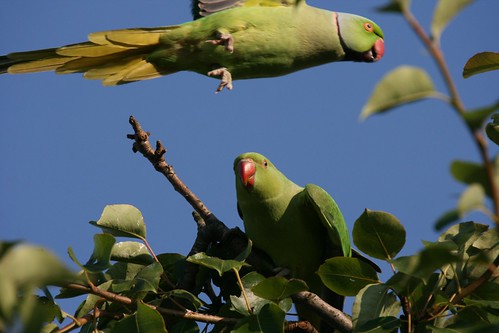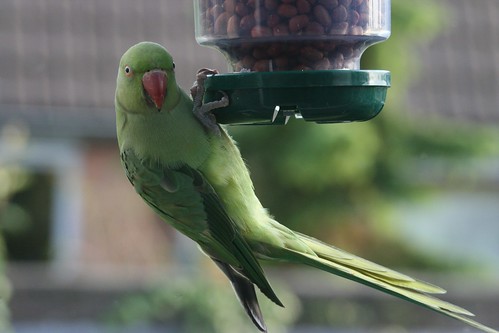The fear of nest robbers
 Friday, May 11, 2012 at 13:56
Friday, May 11, 2012 at 13:56  Ring-necked parakeets nest in their thousands in the Rhine-Main regionDieter Zingel in conversation with Dieter Kassel
Ring-necked parakeets nest in their thousands in the Rhine-Main regionDieter Zingel in conversation with Dieter Kassel
The Ring-necked parakeet has the widest range of any parrot. They have now also settled the Rhine-Main area in Germany. The green birds are suspected of being nest robbers. "This is often overstated," says amateur ornithologist Dieter Zingel.
Dieter Cassel: For over 40 years Ring-necked parakeets have been spreading around Germany, birds that really have no business here. They are green and very pretty. People usually look forward to meeting these birds in city parks. And it is no longer difficult to do so, at least in certain areas. In Cologne, Heidelberg, and especially in the Rhine-Main area Ring-necked parakeets are abundant. Overall Germany presently has 8000 to 9000 of these birds.
As I said, the public mostly enjoys them but some conservationists express concerns: Ring-necked Parakeets supposedly take over woodpeckers nesting cavities and are therefore a threat to native fauna. Dieter Zingel has been observing Ring-necked parakeets in his hometown Wiesbaden since their introduction in 1974. He observes them there, especially at the Biebrich Palace Park, where there are quite a few. But he is not this moment, at this moment he is at the studio of our colleagues from Hessian Radio. Good afternoon, Mr. Zingel!
Dieter Zingel: Good day, Mr. Kassel!
Kassel: In your opinion should German Woodpeckers, Doves, Nuthatches and other birds fear their nests be taken over by Ring-necked parakeets?
Zingel: Not really, because the woodpeckers excavate new cavities each breeding season. Other cavity nesting birds like Ring-necked parakeets happily utilize the old woodpecker dwellings. There is perhaps one species which, I would say, that can be driven of its nesting cavity by the parakeets and that is the Stock Dove (Columba oenas). But the dove ... and this is such a large bird that does not fit in old Green Woodpecker or Great Spotted Woodpecker nesting cavities, is usually found in ancient trees with rotten in knotholes, and occasionally get expelled by the larger Alexandrine parakeets, especially in the Cologne area.
Other cavity-nesting birds such as starlings usually have no problem, also the jackdaw has no problem. In regard to interspecific competition for nesting cavities, at least here in Wiesbaden, the native birds win. We can even prove that in one situation a tiny blue tit pair has prevented Ring-necked parakeets from breeding in a woodpecker hole, and moved in themselves.
 Fighting fiercely among eachoter Ring-necked parakeet give in surprisingly quickly when competing with native birdsKassel: I can’t belief that, considering the size difference between these two birds. Are Ring-necked parakeets particularly faint-hearted then or not as strong as they look?
Fighting fiercely among eachoter Ring-necked parakeet give in surprisingly quickly when competing with native birdsKassel: I can’t belief that, considering the size difference between these two birds. Are Ring-necked parakeets particularly faint-hearted then or not as strong as they look?
Zingel: Ring-necked parakeets and also Alexandrine parakeets will fight fiercely among themselves over a nesting cavity. So much so that it can lead to true aerial combat and severe biting. But in interspecific competition they give in very quickly. This is quite surprising. In Sri Lanka we have seen an Alexandrine parakeet driven off a woodpecker cavity by a Mayna, a bird only half as big as these parakeets. So this is one issue that is often overstated in the media, the press regularly reports things that simply aren’t true.
And there is Ulrike Ernst from Cologne, who wrote her dissertation on the parakeets in that city and has come to similar conclusions as I, with one exception: that the stock dove, that only fits in larger cavities due to its body size, is not interested in woodpecker cavities at all. In the forests, however, they do use in the huge hollows the black woodpeckers make.
Kassel: There are also other – be it rumors or not - allegations against the Ring-necked parakeet that I would like you to clarify, this time nothing to do with other species, but rather with homeowners. These have allegedly complaint about Ring-necked parakeets digging holes in the walls of their insulated houses, for breeding. Is that true?
Zingel: Yes. We have seen this in Wiesbaden, in house walls with insulation. But I have to say that in the Wiesbaden area, however, these walls have first been discovered by Great Spotted Woodpeckers. They initially cut into these walls, possibly to find insects, because when you knock against such an insulated wall, it sounds very much like hollow tree. The clever parakeets then discovered these holes and started raising their families in them, repeatedly so. But we also received reports of parakeets now independently entering insulated house walls without the help of woodpeckers and raising their brood.
Kassel: This is the damage they can cause to walls with insulation. But they also have a reputation for occasionally causing damage in gardens.
Zingel: Yes, definitely. Ring-necked parakeets in their Asian homelands of India and Sri Lanka, are regarded a serious crop pests. They go at all types of grain and fruits. However, we have not yet seen them eating grain here. However, when a flock of about 20 of these birds drops by your walnut or a fruit tree, then you may be left with little to harvest. The birds are extremely wasteful with their food and keep biting of new fruits.
For the parakeets what the tree has to offer is far to tempting. Whether from their mouth, or from their feet, when they drop their fruit they won’t fly after it but rather bite of a new one. I personally experienced significant losses this way with our pear tree.
Kassel: Now people realize that you are actually a big fan of these birds. You observed them since 1974. It must be a great dilemma when you come into the garden and the pear tree is plundered?
Zingel: That’s true. You need to spend some time on it ... So if one is interested in their own fruit harvest, then one should, at time the fruit is ripe - because I am retired I have this time - be present in the garden as much as possible. When these guys come in a simply clap in the hand will be sufficient to disperse them.
They are subject to the conservation law, that is, even Horticulturists, Vineyard’s and other farmers when the parakeets descend on their fields or on their orchards, they can only use the usual methods, also used for thrushes and starlings. The birds cannot legally be hunted, so they may only be dispersed by conventional methods and not be shot.
Kassel: This afternoon Deutschlandradio Kultur speaks with hobby ornithologists and parrot expert Dieter Zingel, who has been observing Ring-necked Parakeets and other birds in Wiesbaden since 1974. There are now around 8000 to 9000 parakeets in Germany. But, Mr. Zingel, as you already explained, they actually come from Southern Asia, particularly India and Sri Lanka. Why the sudden appearance of these birds in Wiesbaden from 1974?
Zingel: I must start by saying that the Ring-necked parakeet is the parrot with the widest range of any parrot, in fact, they live on two continents, Africa and Southeast Asia. Man has recently brought them to two other continents, namely to Europe and America. The populations here in Europe started in the 60ties when the import restrictions on exotic animals were lifted.
Ring-necked parakeets were offered in their thousands, imported from Africa but also from South East Asia and especially India, and for very little money in pet shops, but even in large department stores, that had pet departments. The people who bought these birds, soon realized that they were not well suited for being a pet bird. They are very loud, they have a strong need for exercise, and when loose in the home will chew on things, even valuable teak or a rosewood cabinet. People got rid of this bad bargain and just released them into the wild. Also parakeets escaped from transports, and there were certainly people who have played for God and deliberately released these birds.
Kassel: There are such instances, not only with birds, but with many animals that were released or escaped anywhere from stores to zoos. Presently there is, somewhere in the vicinity of Hamburg, a population of wild Rheas, a South American Ostrich-like bird. One sees a kind of globalization of the animal world - what do you think of this? I mean, those which are here are here and we have to learn to live with them, but is this really a good thing?
Zingel: In this sense, not really, this globalization is where the human species failed because we are responsible for bringing these animals here, and were not careful in letting them escape, this "fauna falsing" is quite simply man's fault, and you should really ask the people: How we can get a grip on this situation again? Some of these animals that have migrated here like some crayfish or the Chinese mitten crab now inhabit large parts of the Rhine and make life difficult for our native crayfish. But I too don’t have a magic formula on how to respond to this globalization of the animal kingdom either.
Kassel: That was the amateur ornithologist and parrot expert Dieter Zingel, we spoke with him about the Ring-necked parakeet, of which there are now 8000 to 9000 in Germany.

